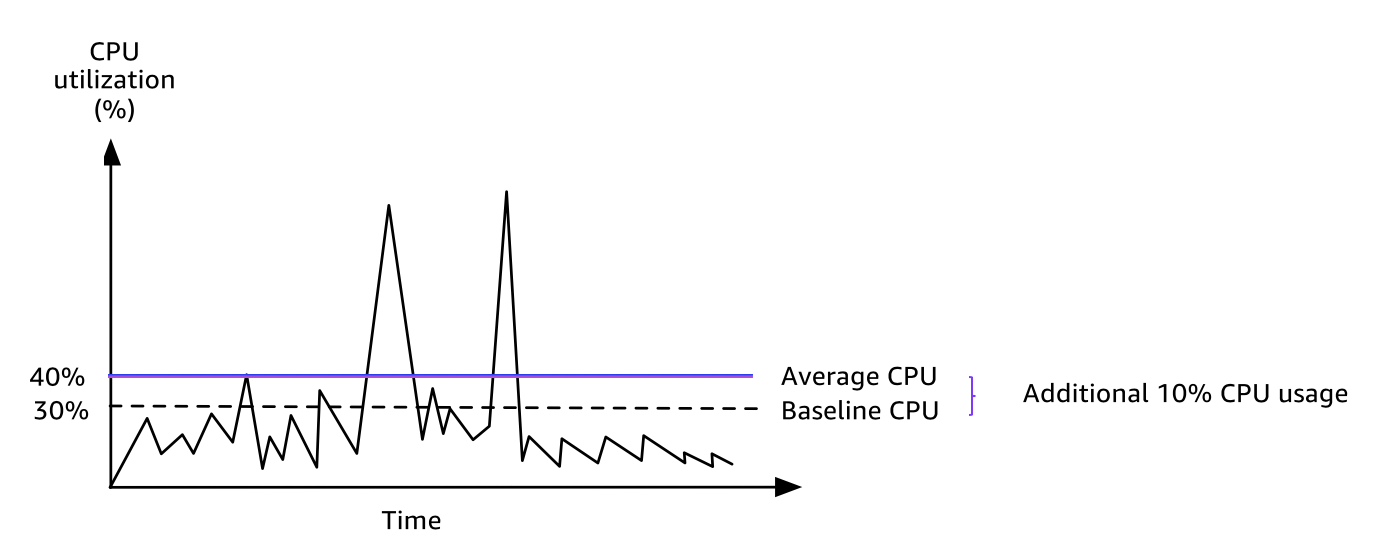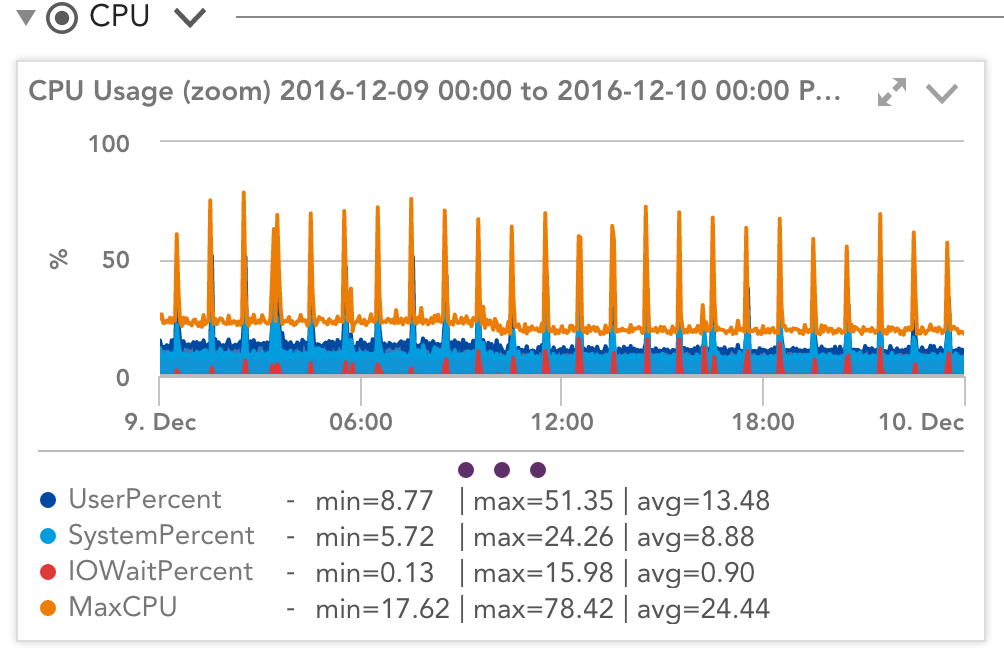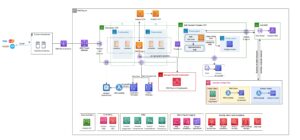AWS CPU credits are a system used by Amazon Web Services to manage CPU utilization for instances in burstable performance instance families. CPU credits are earned at a specific rate and can be used when the instance requires more CPU resources than its baseline level.
Each instance family has a baseline CPU utilization level and a credit balance. When the instance’s CPU usage is below the baseline level, it earns CPU credits, which can be used when the CPU usage exceeds the baseline level. This allows instances to burst their CPU performance temporarily without incurring additional costs.

Credit: docs.aws.amazon.com
Introduction To Aws Cpu Credits
AWS CPU credits allow users to burst CPU capacity beyond the base performance of their instances. When the system is idle or running below baseline, CPU credits are earned. These credits can then be used when the CPU needs to burst above the baseline.
This provides flexibility and cost-effectiveness for fluctuating workloads on AWS instances.
The Concept Of Cpu Credits
In AWS, CPU credits are a way to manage CPU usage efficiently.
Benefits For Aws Users
AWS CPU credits help users optimize costs and performance.

Credit: www.logicmonitor.com
T2 And T3 Instances: The Basics
AWS CPU credits play a vital role in T2 and T3 instances. These credits are earned when your workload operates below the baseline performance level, and can be used when the workload requires higher performance. It’s an efficient way to manage your instance’s performance and optimize costs on AWS.
Characteristics Of T2 And T3 Instances
T2 and T3 instances are types of burstable performance instances provided by Amazon Web Services (AWS). These instances are designed to provide a baseline level of CPU performance with the ability to burst above that baseline when needed. T2 instances are the first generation of burstable instances, while T3 instances are the newer and more powerful second generation. Both T2 and T3 instances are built on the Nitro system, which provides high-speed network and EBS (Elastic Block Store) performance.Ideal Use Cases
T2 and T3 instances are best suited for workloads that do not require sustained high CPU usage but occasionally need bursts of CPU performance. These instances are ideal for small to medium-sized databases, web servers, development environments, and test environments. T2 and T3 instances are also well-suited for applications with unpredictable traffic patterns, as they can quickly scale up to meet demand during peak periods and then scale back down during quieter periods to save costs. In conclusion, T2 and T3 instances are a cost-effective option for workloads that require burstable CPU performance. With their flexible scaling capabilities and high-speed performance, T2 and T3 instances are an excellent choice for many types of applications.Earning Cpu Credits
Earning CPU credits on AWS is an essential aspect of optimizing the performance and cost-effectiveness of your instances. Understanding how CPU credits are earned empowers you to make informed decisions about resource allocation and usage. Let’s delve into the intricacies of earning CPU credits and the factors that influence this process.
Accumulation Over Time
The accumulation of CPU credits over time is a dynamic process influenced by the utilization of your T instances. When your T instance operates below its baseline performance level, it accumulates CPU credits. These credits are then available for burstable performance when your instance exceeds its baseline, ensuring consistent and reliable operation.
Factors Affecting Credit Rate
Several factors can impact the rate at which your T instance earns CPU credits. The instance size, workload pattern, and the presence of surplus credits all play a role in determining the credit accumulation rate. Understanding these factors allows you to fine-tune your instance’s performance and maximize the utilization of CPU credits.
Spending Cpu Credits
When an instance runs out of CPU credits, its performance drops down to the baseline performance level. The instance can accumulate credits when it is idle, and these credits can be used later when the instance requires additional CPU power. However, if the instance runs out of credits, it can still access all its data and continue to function, but at a slower pace.
Conditions For Credit Consumption
CPU credits are consumed when the CPU usage exceeds the baseline performance level for an instance. The amount of credits consumed depends on the instance type and the difference between the actual CPU usage and the baseline performance level.
When an instance requires more CPU power than it has credits, the remaining credits are used up and the instance’s CPU usage drops down to the baseline level. The instance can accumulate credits again when the CPU usage is low.
Monitoring Credit Usage
You can monitor CPU credit usage for an instance using Amazon CloudWatch. This service provides you with detailed metrics on CPU usage, credit usage, and credit balance. By monitoring these metrics, you can ensure that your instances have enough credits to run efficiently.
You can also set up CloudWatch alarms to notify you when your instances are running low on credits. This allows you to take action before the instance’s performance drops down to the baseline level.
Overall, understanding how CPU credits work is essential for optimizing your AWS instances’ performance. By monitoring credit usage and setting up alarms, you can ensure that your instances have enough credits to run efficiently.
Cpu Credit Balance Management
When using AWS EC2 instances, it is crucial to understand how CPU credits work and how to manage your CPU credit balance effectively. CPU credits are a vital resource that determines the performance of your instances and can impact their ability to handle bursts of CPU utilization.
Strategies To Optimize Credit Balance
Optimizing your CPU credit balance is essential for maintaining consistent performance and avoiding unexpected resource limitations. Here are some strategies to help you optimize your credit balance:
- Right-sizing your instances: Choose the appropriate instance type based on your workload requirements. Over-provisioning or under-provisioning instances can lead to inefficient credit utilization.
- Monitoring CPU utilization: Keep a close eye on your CPU utilization to identify any patterns or spikes. This can help you adjust your instance type or make necessary optimizations to prevent credit depletion.
- Utilizing burstable instances: Burstable instances, such as the T3 and T2 instances in AWS, provide baseline performance with the ability to burst when needed. Understanding the burstable model and leveraging it appropriately can help you maximize your credit balance.
- Implementing auto-scaling: Utilize AWS Auto Scaling to automatically adjust the number of instances based on your workload. This can help distribute CPU utilization and ensure a balanced credit usage across instances.
Tools For Management
AWS provides various tools to help you effectively manage your CPU credit balance. These tools enable you to monitor, analyze, and optimize your instances’ performance. Some of the key tools for managing your CPU credit balance include:
- AWS CloudWatch: Monitor your CPU utilization and credit balance using CloudWatch metrics. Set up alarms to notify you when your credit balance is running low or when CPU utilization exceeds your specified threshold.
- AWS Trusted Advisor: Leverage the CPU credit balance check in AWS Trusted Advisor to receive recommendations on optimizing your credit utilization and maintaining a healthy balance.
- AWS Cost Explorer: Analyze your CPU credit usage and associated costs using AWS Cost Explorer. This tool allows you to track your credit consumption and optimize your resource allocation accordingly.
By implementing these strategies and utilizing the available management tools, you can effectively manage your CPU credit balance, ensure optimal performance, and avoid unexpected resource limitations on your AWS EC2 instances.

Credit: stackoverflow.com
Scaling With Cpu Credits
CPU credits are a vital component of how AWS manages CPU usage for EC2 instances. Scaling with CPU credits allows for efficient resource utilization and cost management.
Handling Traffic Spikes
During periods of increased traffic, EC2 instances may consume CPU credits at a faster rate, potentially leading to a depletion of credits and subsequent performance degradation.
Autoscaling And Credit Usage
Autoscaling can help mitigate CPU credit depletion by dynamically adjusting the number of instances based on demand, ensuring consistent performance and efficient credit utilization.
Cost Efficiency And Cpu Credits
Cost Efficiency and CPU Credits play a crucial role in optimizing AWS instance performance and managing costs effectively.
Budgeting For T2 And T3 Instances
When using T2 and T3 instances, it’s essential to understand how CPU credits impact your budget.
Comparing Costs With Other Instances
It’s important to compare costs of T2 and T3 instances with other options to ensure cost-effectiveness.
Best Practices For Maximizing Cpu Credits
Maximizing CPU credits is crucial for optimizing AWS instances. CPU credits are earned over time and used when the instance needs additional processing power. By following best practices such as monitoring usage and choosing the right instance type, users can effectively manage CPU credits and minimize costs.
Best Practices for Maximizing CPU CreditsBalancing Performance And Cost
Achieve optimal performance while controlling costs.
Real-world Examples
Learn from practical scenarios to enhance efficiency.
Troubleshooting Common Issues
AWS CPU credits work by providing burstable performance for T2 and T3 instances. These credits accumulate when the instance runs below its baseline. When the instance needs more performance, it consumes these credits. Understanding how CPU credits work is crucial for troubleshooting performance issues in AWS environments.
Depleted Cpu Credit Scenarios
Resolving Performance Bottlenecks
In troubleshooting common issues with AWS CPU credits, understanding depleted CPU credit scenarios is crucial.
One common issue is running out of CPU credits, which can lead to performance bottlenecks.
- Monitor CPU credit balance regularly.
- Check instance type to ensure it supports burstable performance.
- Review usage patterns for any sudden spikes in CPU utilization.
Depleted Cpu Credit Scenarios
| CPU Credit Scenario | Action |
|---|---|
| CPU credit balance is consistently low. | Consider upgrading to a non-burstable instance type. |
| Sudden performance drop during high traffic. | Investigate resource-intensive processes and optimize them. |
Resolving Performance Bottlenecks
- Identify applications consuming high CPU.
- Adjust instance type or size for better performance.
- Implement auto-scaling to handle traffic spikes efficiently.
Future Of Cpu Credits And Aws
The future of CPU credits and AWS looks promising as the platform continues to evolve.
Evolving Aws Pricing Models
AWS is constantly updating its pricing models to meet users’ needs.
Predictions For Cpu Credit Enhancements
Experts predict enhancements in CPU credit allocation for better performance.
Frequently Asked Questions
What Is Cpu Credit Balance In Aws?
CPU credit balance in AWS refers to the amount of credits available for a CPU to use in a given period. Credits accumulate over time and can be used when needed to burst CPU usage beyond the baseline limit. The credit balance decreases when the CPU usage exceeds the baseline limit and increases when the CPU usage is below the baseline.
What Happens When Cpu Credits Run Out?
When CPU credits run out, performance may be limited until more credits accumulate. Website speed and responsiveness could be affected.
What Is Per Vcpu Hour?
Per vCPU hour refers to the cost of using one virtual CPU for one hour. It’s a pricing model for cloud computing services.
What Is Compute Credits?
Compute credits are a form of currency used in cloud computing services. They allow users to pay for resources consumed, such as CPU usage and storage. These credits can be purchased in advance and are deducted as resources are utilized.
They provide flexibility and cost control for cloud users.
Conclusion
Understanding how AWS CPU credits work is crucial for optimizing your cloud computing experience. By effectively managing your CPU credits, you can ensure that your applications run smoothly and avoid unexpected performance issues. With a clear understanding of how CPU credits are earned, accrued, and utilized, you can make informed decisions to optimize your AWS resources and cost-effectively meet your computing needs.
Stay informed and utilize the power of CPU credits to maximize your AWS performance.






